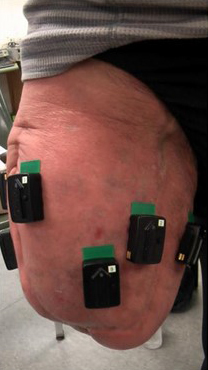Research & Innovation based on the research by Dr. Helen (He) Huang
Background
Whether it is something as simple as picking up an object or as complex as human locomotion, being able to restore some of an amputee’s lost movements allows them to live a more normal, fulfilling life. Prosthetics have evolved drastically since the earliest days of peg legs and hand hooks. Active prosthetics, the current state-of-the-art technology, relies heavily on electromyographic (EMG) signals from an amputee’s residual limb to evaluate and control modern prostheses.
Researchers continue to explore the design and development of active prosthetics and in recent years technological advancements have led to the use of EMG signals recorded from the residual muscles of lower-limb amputees to control dynamic movements. At the University of Texas-Austin customized lower-limb prosthetics (Dr. R. Neptune et. al)1 are designed for soldiers who were injured in the line of duty. This group incorporates the EMG recording from an amputee’s residual limb to design a custom prosthesis to maximize the integration of the prosthetic socket with the residual limb.
keywords: prosthesis, active prosthetics, amputation, residual limb, electromyography, socket-sensor configuration, motion artifact
Dr. Helen (He) Huang
Since mid-2000, Dr. Huang has been working to understand how neuromuscular signals are coordinated to improve movement control of prostheses. Her research group has focused on various topics, from optimizing the filtering of EMG signals following muscle reinnervation2 to current a project involving pattern recognition of EMG signals for prosthetic arm control3. In her group’s most recent contribution, Dr. Huang and her team investigated EMG signal quality from four different collection systems (Table 1, Pros. and Orth. Int, 2014).
EMG from lower-limb socket–sensors offer insight into the factors that could influence the design and clinical evaluation of prosthesis for reliability, stability and comfort4.
Dr. Huang’s group compared EMG signals from four different socket-sensor prosthetic configurations worn by a transfemoral amputee while three different movement types were performed. Raw EMG signals were filtered using a 20-450 Hz band-pass filter and rectified. Motion artifacts were determined by filtering signals with a 20 Hz low-pass filter and identifying threshold voltages. Configurations were evaluated on EMG signal quality, visible skin irritation, and user comfort.
According to her study, Trigno™ Wireless EMG System was found to excel in all three categories, producing the least amount of large amplitude motion artifacts, least amount of visible skin irritation, and the most comfortable configuration according to the user.
Conclusion
Dr. Huang’s study published in Prosthetics and Orthotics International concludes that Trigno™ wireless sensors provide the most accurate and reliable EMG signal when used in a prosthetic socket. Of equal importance, the sensors provided the most comfortable
experience for the subject.
References
- Fey N, Klute G, Neptune R. Altering prosthetic foot stiffness influences foot and muscle function during below-knee amputee walking: A modeling and simulation analysis. Journal of Biomechanics 46. 637-44. 30 November 2012.
- H. Huang, P. Zhou, G. Li, and T. Kuiken, “Spatial filtering improves EMG classification accuracy following targeted muscle reinnervation,” Ann Biomed Eng, vol. 37, pp. 1849-57, 2009.
- UNC/NCSU Joint Department of Biomedical Engineering – He (Helen) Huang. 14 May 2014.
- <http://www.bme.unc.edu/index.php/directory/userprofile/hhuang11>.
- Hefferman G, Huang H, Nunnery M, Zhang F. Integration of surface electromyographic sensors with the transfemoral amputee socket: A comparison of four differing configurations. Prosthet Orthot Int. 27 January 2014.
- Norton, Kim. “A brief history of prosthetics.”Motion. 2007.
- www.delsys.com
Delsys EMG Systems
Delsys EMG systems feature wired and wireless surface EMG sensors, designed to produce a consistent EMG signal with low muscle crosstalk and reduced motion artifact.
The wireless sensors allow the subject to move freely, allowing for natural movements and accurate evaluations during prosthetic testing.
The Study Parameters
Sitting/Standing
Stair Ascend/Descend
Level ground walking
The Study Focus
Quality of the EMG signal
User comfort
Skin irritation
Delsys Instruments Used in the Study
16 sensor Trigno™ Wireless EMG System
16 channel Myomonitor® semi-wireless EMG System


